Sample Pronouns Research Paper. Browse other research paper examples and check the list of research paper topics for more inspiration. If you need a religion research paper written according to all the academic standards, you can always turn to our experienced writers for help. This is how your paper can get an A! Feel free to contact our research paper writing service for professional assistance. We offer high-quality assignments for reasonable rates.
Noun referents can be substituted by personal pronouns. In most contexts the pronoun is coreferential with and interchangeable with the noun to which it refers. Other pronouns determine nouns, some have the capability of doing both. In English, the personal pronouns substitute, the articles determine, and the demonstratives do both. These, together with indefinites, negatives, locatives, interrogatives, and relatives are grouped together as non-personal pronouns.
Academic Writing, Editing, Proofreading, And Problem Solving Services
Get 10% OFF with 24START discount code
The word tree refers to an object in the real world (exophoric use), but it can have meaning only in referring to some noun such as tree by being coreferential with it (endophoric use). Within the linguistic context it can replace tree or any other noun of the same class—but not, for example, man or trees, which require special pronominal forms in English.
Pronoun sets can also be distinguished on the basis of case and emphatic differences. Not all pronouns are in fact interchangeable with nouns, such as the reflexives, the logophorics, and the sequentials. Pronouns may be morphologically free or bound, that is, they may be separate words or affixes.
Instead of treating pronouns as part of the lexicon, Everett (1996) argues for considering them to be composed of phi-features, such as case, gender, number, tense, and person. These phi-features are stored in the lexicon, their phonological shapes are given by postlexical or precompiled spell-out rules.
1. Personal Pronouns
The personal pronouns can be studied under the parameters of person, number, and gender distinctions, which vary considerably from one language to another.
1.1 Person
In the person parameter, the third persons (he she it they) are usually used endophorically, whereas the first and second persons (I, we, you) are frequently used exophorically.
The only language with person but no number distinctions reported to date is Mura Piraha, an unclassified Amerindian language (Brazil). First, second, and third constitute the only formal pronoun distinction this language has. One language has been found which appears to distinguish in the pronominal system two persons only: first and nonfirst. In the Balante variety spoken in Guinea-Bissau, N-(homorganic nasal) is used for 1sg, hafor 2sg or 3sg, and be-for plural in any of the three persons.
Many languages have pronouns that combine 1 + 2 persons; that is, speaker and hearer, into an inclusi e first person. This is in contrast to the 1 + 1 or first person exclusi e category, in which the hearer is excluded explicitly. Some languages combine other categories as well, such as 1 + 3—that is, speaker plus one person not present; 2 + 3—grouping together one hearer and one person not present; and 3 + 3—grouping together two persons not present. In addition to binary combinations, the tertiary combination of 1 + 2 + 3 is sometimes used, where everybody is included explicitly (particularly the ancestors).
1.2 Number
The person distinctions are usually combined with number distinctions, singular and plural being the most common. When person categories are combined, making the smallest possible number two, or even three, it is more sensible to talk about a minimumplural distinction. The most complex person-number combinations so far reported are found in Ghomala’ (Bameleke, Cameroon). The plural categories have hierarchical order: first person comes before second, which comes before third.
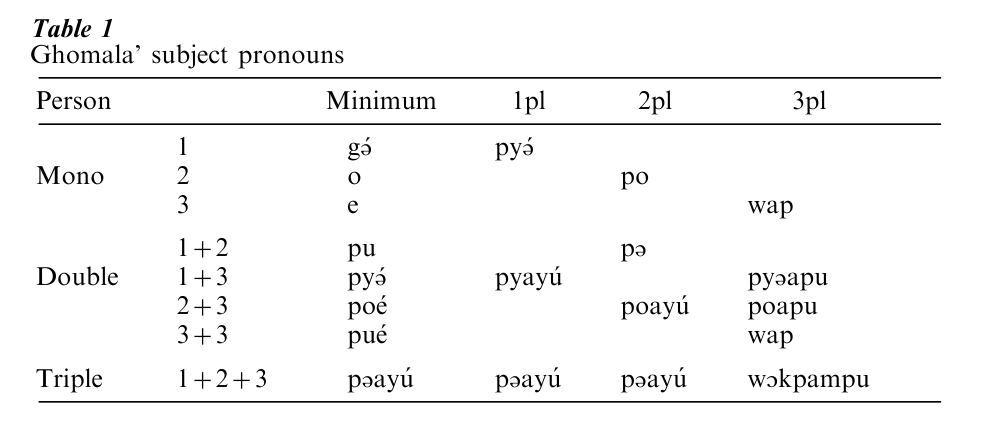
Sursurunga (New Guinea) has what is probably the most complex number system in operation with mono, dual, triple, and quadruple, as well as four-person distinctions (Hutchisson 1986).
1.3 Gender
Gender distinctions are basically of two kinds: natural gender, such as masculine, feminine, and neuter (or animate inanimate, human non-human, for example), and grammatical gender having to do with noun classes. The latter is common in African and some Asian languages. Normally, gender distinctions are restricted to the third person, but may be found in other persons as well, particularly in possessive function.
1.4 Honorific Use
Many languages have special uses of pronominal forms for showing respect or social distance. Instead of the second singular, the plural may be used. Completely different pronouns can also be found. For Bangkok Thai, 17 different forms for first, 19 for second, and 10 for third person are in use, distinguished by such categories as power and status, kinship, friendship, occupation, ethnic–religious groups, age, sex, genealogical distance, solidarity, formality, presence of certain persons, emotional manifestations, and combinations of all these (Palakornkul 1975).
1.5 Special Meanings
There may also be unusual uses of person distinctions. Exclusiveness may be an added dimension to any of the personal pronouns, though there are no special forms to mark the distinction. In several Amerindian languages the 1sg has the exclusive meaning of ‘only I (speaker), but not anybody else,’ whereas the second means ‘only you (hearer) but not I’ (speaker). The only pronoun which can be used inclusively is the 1pl form.
Other pronouns can have meanings which are not apparent from examining the system. In Kaingang (Je, Brazil) whenever a family unit is involved, the 3pl fem. form is used after the name of the man; the 3pl masc. is reserved for a group of men only.
2. Nonpersonal
Nonpersonal pronouns are used in the third person only, but may vary in number and gender.
2.1 Definite
Demonstratives and articles are included in the series of definites. A distinction is often found according to where the determined noun is placed in relation to the speaker and/or the hearer, which gives a two-or three-way distinction, as when the locative adverbs are used pronominally.
In English:
(a) the man is anaphoric: the already mentioned;
(b) this man is close to speaker (often anaphoric);
(c) that man is far from speaker (often anaphoric);
(d) this makes me wonder if … .
This and that may be used as substitutes (exophorically) if the object is in sight (and in that case not necessarily anaphorically) or to replace arguments and other parts of discourse. In German the articles may substitute for the noun.
In Didinga (Nilo-Saharan, Sudan) separate forms exist for information that is generally known as against exclusive knowledge of the speaker; or whether the pronoun refers to a happening long ago or recently, or whether the person was referred to recently or much earlier.
2.2 Indefinite
A number of languages also have indefinite pronouns, referring to no one in particular, but rather to everyone or certain unspecified individuals, such as they in English or on in French. The second person, singular or plural, might be used in this way also: you don’t beat children!
Among the indefinite forms can be classed such words as a, certain, other, such, few, some, many, any, and others. Some languages class the distributives among the indefinite, such as all, every, each, both, half, part of, some, another, other, either, and others.
2.3 Negative
Certain forms are entirely negative. They are often subsumed under indefinite. In English they include none, nobody, nothing, no, neither. In many languages the negation is not expressed in a pronoun (or noun) but rather in the verbal expression.
2.4 Interrogative
In all languages, people ask questions with the aid of interrogative substitutes or determiners. Some of these are simple, others are constructed from simple forms. In English, the simple forms are how? what? when? where? which? who? whom? whose? why?, constructed forms how many? whate er?, and others.
Some languages form interrogatives from demonstratives, such as:
Fulfulde (Cameroon)
(a) dewtere nde’e ‘this book’ (demonstrative)
(b) dewtere ndeye ‘which book? (interrogative)
(c) gorko o’o ‘this man’ (demonstrative)
(d) gorko oyo ‘which man?’ (interrogative)
2.5 Relative
Relative constructions usually contain a relative pronoun, which may be a demonstrative or an interrogative, or an entirely different form, restricted in use to relative constructions. English: ‘Here is the one who could help.’ In Konzime (Cameroon), the pronoun comes at the end of a relative construction and can be:
- either a special relative pronoun which varies according to the noun classes; or
- the demonstrative n ı which is invariable.
In some languages the relative pronouns also indicate differences in tense and form part of the verbal paradigm:
Denya (Ekoid, Cameroon)
(a) a-wa ‘he killed’ – a-wa-ne ‘he who killed’
(b) a-wa-ne ‘he kills’ – a-wa-ne ‘he who kills’
2.6 Pronominally Used
A number of adverbs have pronominal use, especially the indicators of space and time. The locative adverbs indicate at least three different localities: close to speaker, close to hearer (but far from speaker), and far from both, as in English here—there—yonder. There may also be other types of information, such as inside, outside, underneath, abo e, before, after that could be counted among them.
Nouns can also be used pronominally, especially (but not only) as honorifics. In Brazilian Portuguese, a gente ‘the people’ is commonly used instead of nos ‘we’.
3. Set Distinctions
In noun phrases and clauses, pronouns may be marked for any case distinction found in the language. Case indicators including circumstantial information may be fused to the pronouns causing different sets. English distinguishes I–me, he–him, she–her, we–us, they–them. Yaoure (Ivory Coast) shows pronoun fusion with postpositions (Hopkins 1986):
ı + lε → jıε ‘2sg + of → of you sg’
ka + lε → kε ‘2pl + of → of you pl’
3.1 Genitive
In genitive constructions the possessor can be replaced by a pronoun. The possessed item often takes the mark of the clause level function, whereas the mark on the possessor identifies it as such by the genitive case. The agreement rules of the associative noun phrase can be quite complex and varied.
English:
(a) John’s book – his book (agrees with John)
(b) Mary’s book – her book (agrees with Mary)
French:
(a) le livre de ‘the book of
Jean – son livre John – his (masc) book’
(agrees with book)
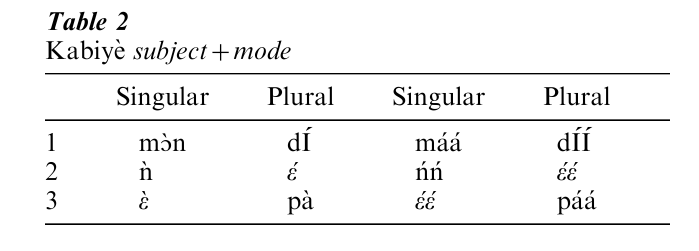
(b) la case de ‘the hut of
Jean – sa case John – his (fem) hut’
(agrees with hut)
(c) les livres de ‘the books of
Jean – ses livres John – his (pl) books’
(agrees with books)
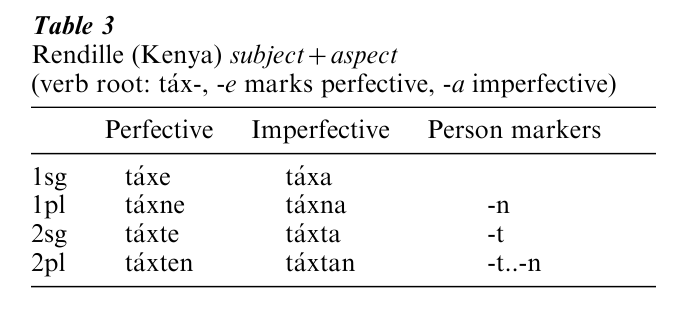
African class languages show a wealth of pronominal forms in all the cases. In the genitive, agreement holds in first and second person as well. The agreement may be with the possessor (as in English) or with the possessed item (as in French), or with both.
There may be different kinds of genitives, such as alienable and inalienable possession. The differences may be marked in the pronoun sets:
Lendu (Zaire)
(a) ma ndza buku ‘my book’ alienable/
possessive
my of-cl. book
(b) nı dhı buku ‘your book’
your of-cl. book
(c) ma djo ‘my brother’ inalienable/
qualificative
my brother
(d) n’ı djo ‘your brother’
your brother
In the alienable construction, the tone of the possessor pronoun is different from the inalienable construction, and the alienable particle ‘of’ (which changes in form according to noun class) is absent in the inalienable construction.
3.2 Noun Phrase Substitution
The whole possessive noun phrase can be substituted by a pronoun or a nominalized or adjectivized pronoun, which functions on clause level and may carry case markers, as in German:
(a) Mutters Garten – ihr Garten – ihrer – der ihrige
(b) mein Garten – meiner – der meinige
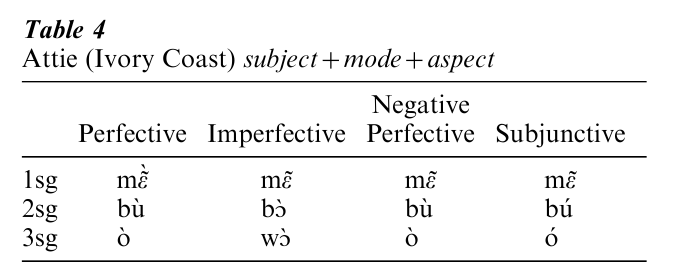
3.3 Subject + Distinctions
Subject pronouns may contain, in addition to person, number, and gender information, a case marker, combined with verbal information such as mode—as illustrated from Kabiye (Togo), or aspect as illustrated from Rendille (Kenya), or a combination of these, as illustrated from Attie (Ivory Coast).
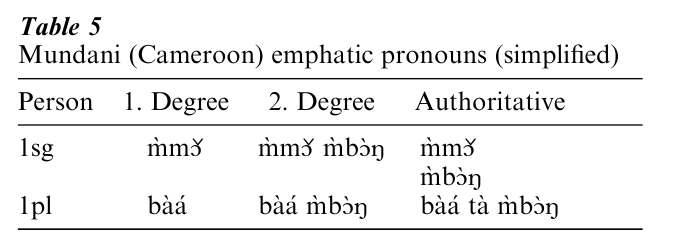
The Kabiye irrealis pronouns seem to be a fusion of the first series plus a suffix -ka, which is seen in its full form when following nouns.
The Attie imperfective can be reconstructed as a fusion of the perfective plus a suffix -a. In the negative perfective series, only two forms are different from the perfective: the 1sg and 2pl forms have high instead of low tone. Nevertheless, the whole set constitutes a new series. The subjunctive forms all have high tone.
3.4 Emphatic
Emphatic pronouns can be found in all languages, especially in subject function. These are usually focus forms, which can also be differentiated by degree. All of these differences can result in different pronoun series.
In Bafut (Gr assfields, Cameroon), in addition to the location an insistence distinction adds members to the demonstrative set. These distinctions go from 0, the ‘normal’ form, to 3, where the people are actually shouting at each other. Since Bafut is a class language, the whole set includes corresponding forms for each class; class 5 forms are presented here. The location distinctions are: nu ‘close to speaker’—nı close to hearer’—nyaa ‘far from both,’ and all have corresponding forms:
(a) nıba nu ‘this (here) wing’ (0)
(b) nıba nua ‘(no,) this (here) wing!’ (1)
(c) nıba nula ‘(no, no,) this (here) wing!’ (2)
(d) nıba nuanuu ‘(of course not!) this (here) wing!’

4. Noninterchangeable
Some pronouns are not interchangeable with the nouns with which they are coreferent. John hurt himself cannot be replaced by *John hurt John without changing the meaning.
4.1 Reflexive And Reciprocal
Reflexive pronouns are used to show that the agent and the patient of an event are coreferent:
(a) Johni hurt himselfi
(b) Johni and Maryk hurt themselvesi+k
(c) Johni and Maryk hurt each other
/one anotheri < − > k
If more than one participant is involved, and in the course of the action they exchange roles, the construction is reciprocal.
The relationship can hold between the subject (or agent) and the possessor:
(d) Johni watched his (own)i son reflexive
(e) Johni watched hisk son not coreferent
4.2 Logophoric
Logophoric indicators, usually pronouns, are found in many African languages. Their primary use is in indirect reported speech. They express coreference between the quoted speaker and any participant in the quote content, but primarily the subject or agent. Tupuri (Cameroon)
(a) Pϧli riη Jaηk ga sεi lε’ε
Pauli said to-Johnk that LOGi fell
‘Paul said to John that he (Paul) fell’
(b) P li riη Jaηk ga ak,l lε’ε
Pauli said to Johnk that hek,l fell
‘Paul said to John that he (John or someone
else) fell’
In all the languages that have such a logophoric indicator, the relationship holds between the quoted speaker and the subject of the quote content. Some languages use the same particle to show coreference between the speaker and other functions in the quote content, such as direct object, indirect object, or possessor.
The logophoric indicator is normally used in the third person, always singular, but sometimes plural as well. Some languages also use it in the second person, and in Lele (Chad) it is used for all three persons, singular and plural. In languages with nominal classes, the marker may be distinguished according to the class of the noun to which it refers (Wiesemann 1986).
Logophorics are used with certain verbs related to speaking, especially the equivalent of ‘say’. Verbs of thinking and feeling may also permit their use. In some languages, the logophoric pronouns can also be used with any verb, in which case the clause is one of intention or cause, which can be interpreted as truncated indirect speech.
Babungo (Grassfields, Cameroon)
ηwϧ nyıη laa Kt vϧη saN yı me
3si flee that NEG 3pk beat LOGi not
‘He fled so they would not beat him’
4.3 Sequential
In a sequence of clauses one may be the principal and the others subordinate to it. This relationship can be made explicit by the form of the subject pronoun. Any dependent clause in which the subject is coreferential with that of the principal one, the same subject (SS) is marked by a special sequential form of the pronoun. Or the converse may be true: any subject that is not coreferent with that of the main clause, the different subject (DS) is marked in some way. This relationship is also called switch-reference (Munro 1979). Bafut (Grassfields, Cameroon)
(a) a-ghεε nda η-kw εrϧ forϧ
3si-go house SSi-take rat
‘… then he went home and caught a rat.’
(b) a-ghεε nda η-kw εrϧ forϧ
3si-go house gwa 3sk-take rat
‘… then he went home and gwa caught a rat’
In Bafut, the SS–DS difference is restricted to the third person subject. In Kobon (Papua New Guinea) all the persons have a different form for SS and for DS, as well as a ‘normal’ pronoun form. The actual use of such forms can be illustrated by:
kobon (Papua New Guinea)
(a) kabo mjanu lau-o in-a
stone that heat-DS3sg hot-3sg
‘he heated the stones and they were hot’
(b) yad kaj pak-em ram ud ar-nab-in
1sg pig strike-SS2sg house take go-FUT-1sg
‘I will kill a pig and take it home.’
Reflexives, Logophorics, and Sequentials can all be marked in the same language, either by the same markers or by different ones. In Mundani (Grassfields, Momo, Cameroon) the sequential pronoun is a homorganic nasal N in imperative and realis mode, and e in irrealis mode, the logophoric pronoun is ye, and the relfexive vi. They work together to keep the participants in a text straight (Parker 1986).
Bibliography:
- Delisle G 1972 Three universal personal pronoun features. Stanford University Working Papers in Language Universals 9: 181–3
- Everett D L 1996 Why There Are No Clitics. An Alternati e Perspecti e on Pronominal Allomorphy. The summer Institute of Linguistics and The University of Texas, Arlington, TX
- Hopkins E B 1986 Pronouns and pronoun fusion in Yaoure. In: Wiesemann U (ed.) Pronominal Systems. Gunter Narr Verlag, Tubingen, Germany
- Hutchisson D 1986 Sursurunga pronouns and the special uses of quadral number. In: Wiesemann U (ed.) Pronominal Systems. Gunter Narr Verlag, Tubingen, Germany
- Ingram D 1978 Typology and Universals of Personal Pronouns. In: Greenberg J H (ed.) Universals of Human Language. Stanford University Press, Stanford, CA
- Munro P (ed.) 1979 Studies in Switch Reference. University of California, Los Angeles, CA
- Palakornkul A 1975 A sociolinguistic study of pronominal usage in spoken Bangkok Thai. Linguistics 165: 11–41
- Parker E 1986 Mundani pronouns. In: Wiesemann U (ed.) Pronominal Systems. Gunter Narr Verlag, Tubingen, Germany
- Wiesemann U 1986 Grammaticalized coreference. In: Wiesemann U (ed.) Pronominal Systems. Gunter Narr Verlag, Tubingen, Germany




